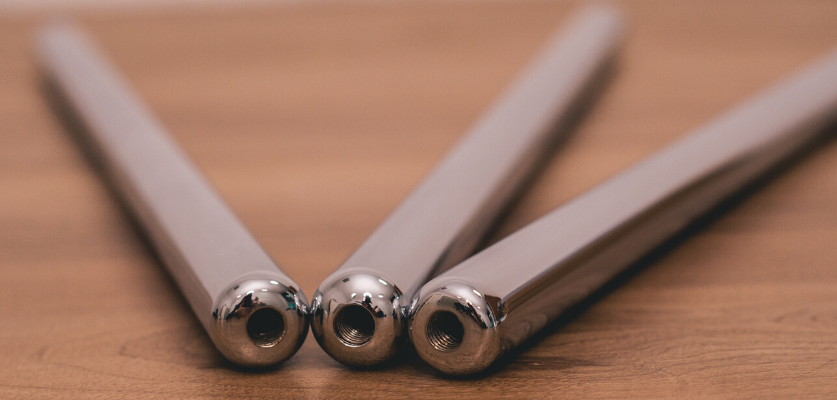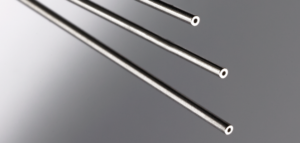Controlling Feature Variation in Two vs. Three Dimensions
We often get asked about the GD&T features that are called out on engineering drawings — and in this blog, we look at two such features: the profile of a line, the profile of a surface, and how they compare.
What Is Profile of a Line?
Generally applied to parts that have varying cross sections or to specific cross sections that are critical to functionality, GD&T profile of a line controls individual lines of a feature, usually having a curved shape.
An example of where profile of a line might be applied is a part feature that curves in multiple axes at once — something that is common for Swiss-style automatic lathe machining but also possible with in-feed centerless grinding. When called out on a feature such as a radius on a part, profile of a line indicates how much a particular cross section of that feature can vary from a true curved radius.
Like circular runout, the profile of a line in GD&T looks at a cross section — in this case, at any point along the linear surface, setting a tolerance zone on either side of the profile.
The profile of a line tolerance zone falls within two parallel curves that follow the contour of that profile. Since measurements might need to be taken at multiple cross sections of a part, the number of cross sections to be measured is usually included on the drawing along with the called-out tolerance.
What Is Profile of a Surface?
The GD&T profile of a surface is a three-dimensional version of the profile of a line — so, like total runout, surface profile does not pertain to just a cross section. Instead, it controls the entire feature surface (again, usually having a curved shape) with the goal of making sure every point falls in the tolerance zone.
In other words, while profile of a line looks only at a specific cross section, profile of a surface looks at how measurements vary from one cross section to the next.
The surface profile tolerance zone is the range that falls within two parallel curves following along the contour of the surface profile across the entire length of the surface. In a typical GD&T profile of a surface example, it might be called out where you have a surface that curves in multiple axes at once and where you want to ensure that every point falls within a specific tolerance.
When profile of a surface is called out on a curved surface such as a fillet on a welded part, the entire surface where the radius is has to fall within the tolerance. Surface profile is also commonly called out for:
- Cast parts with curved surfaces where the amount of variation needs to be controlled
- Complex designs where two parallel surfaces of the same shape must fit together
Profile Line vs. Surface Profile in Precision Parts
Sometimes both profile of a line and profile of a surface are called out; in these cases, the line profile tolerance will be tighter than the surface profile tolerance. This ensures the part will be tightly controlled along any particular cross section while also meeting the looser surface requirement.
Although line profile and surface profile can apply to Metal Cutting’s world of lathes and grinding work, these GD&T features are more commonly applied when we do milling work. However, our in-feed grinding, profile grinding, and CNC grinding techniques can be used to create trapezoidal features or curves on circular parts such as pins or rods.
Surface and Line Profile Features in Grinding and Turning
With in-feed centerless grinding and Swiss-style automatic lathe turning, it is very unusual to have non-uniform surfaces around a single point on a circumference. Along a linear length, you can have all different types of shapes, such as tapers, shoulders, screw threads, and so on.
Complex features such as flats, ovals, and ellipses are possible with the use of special techniques, but oblong and circular features are more appropriate for milling and 3D additive manufacturing.
With lathes and grinding, if the machines are out of true or the spindles are bad, it can result in chatter or distortions in the cross section representing the profile of a line. With the profile of a surface and features such as tapers, shoulders, straight lines, and so on, customers want the surface to be smooth.
However, if the machines are in bad condition and variations are being ground into the parts, that is when shapes become complex in a way that is not intentional or what customers want.
Therefore, it is Metal Cutting’s goal to make the profile of a surface as consistent as the profile of a line. The more perfectly a machine is running, the less complex that shape actually will be because it all points around a 360° circumference, so it will be equivalent to the 2D tolerance.
Grinding 3D Parts with the Right Line Prolife or Surface Profile
When we receive a drawing, it is generally a two-dimensional representation, but we know that our customer wants (and that we need to make) a three-dimensional part. Our in-feed grinding is capable of grinding flat, single-plane sections into complex, round parts with a diameter.
Therefore, the complexity that is implicit in the profile of a surface called out on a drawing is fully understood by us, in terms of not only the tolerance that needs to be kept, but also the parameters that need to be maintained while making the ground finish or turned surface.
Profile of a Line vs. Profile of a Surface in the Polishing Process
For complex shapes — whether we are talking about the final product or the construction of a mold — line profile and surface profile also come up in an unusual circumstance: when we do mechanical polishing.
In this process, we are not only creating ultra-smooth surfaces, but also removing material such as sharp edges, corners, and intersections. It may not be a lot of material, but for our customers and their precision metal parts, even the smallest dimensions matter.
Therefore, the profile of a line tolerance and profile of a surface tolerance become important to the control we exert in our production process. In addition, when Metal Cutting polishes a 3D or molded part being made by an upstream or downstream supplier, we must also take into consideration the amount of material removed during the final polishing so that the supplier accounts for the final material removal in the design process.
Meeting the Requirements for Line Profile and Surface Profile
Here at Metal Cutting Corporation, our goal is to deliver high-quality precision parts that meet your specifications — for line profile, surface profile, and other features — while also keeping your production costs within budget.
To learn more about how specifying GD&T features and tolerances affects the quality of parts manufacturing, download our free paper How to Fine-Tune Your Quote Request to Your Maximum Advantage: Frequently Asked Questions in Small Parts Sourcing.






